![]()
![]()
![]()
Use LEFT and RIGHT arrow keys to navigate between flashcards;
Use UP and DOWN arrow keys to flip the card;
H to show hint;
A reads text to speech;
38 Cards in this Set
- Front
- Back
|
Pathogen characteristics of Actinobacteria
|
Gram +
High G+C content in their DNA (51-65%) |
|
|
Major pathogens of Actinobacteria can be found in this Order...
|
Actinomycetales - many are pyogenic (pus producers)
|
|
|
Pathogen characteristics of Corynebacterium
|
Gram +, High G+C content
Mycolic acids in cell wall Pleomorphic Coryneform Catalase +, Oxidase - Falculatative anaerobes Fastidious (requires enriched growth media to grow) |
|
|
What is meant by the term "Coryneform"?
|
Knotted rod, V-shaped, "Chinese Characters", Palisades
|
|
|
Epidemiology of Corynebacterium
|
Commensals on mucus membranes
Predisposing factors: trauma C. pseudotuberculosis survives well in the environment |
|
|
Pathogenesis of Corynebacterium
|
Opportunistic pathogen
Pus producer/Pyogenic (not C. bovis) |
|
|
Pathogenesis of Corynebacteria pseudotuberculosis
|
Opportunistic pathogen
Pyogenic Intracellular pathogen Toxic cell wall lipid components Phospholipase D toxin --> destroys our cell membranes |
|
|
Clinical signs of Corynebacteria pseudotuberculosis
|
Sheep/goats:
Caseous lymphdentitis - entry through cuts, infection spread by pus from ruptured abscesses and oral/nasal secretions; enlarged submandibular/regional lymph nodes Horses and cattle: Ulcerative lymphangitis - slow/chronic inflammation of lymph vessels, particularly legs Nitrate reducing biotype of C. pseudotuberculosis |
|
|
Distribution of Corynebacteria pseudotuberculosis
|
Unknown in Ireland in sheep/goats
Global distribution in horses/cattle - exotic infection in Ireland |
|
|
Pathogenesis of Corynebacteria renale
|
Opportunistic pathogen
Pyogenic Fimbriae Urease Ammonia - increase pH or urine, promoting growth Shed in infected urine and survive on pasture |
|
|
Clinical signs of Corynebacteria renale
|
Cattle: Cystitis (bladder) and pyelonephritis (kidney)
Rams/Wethers: ulcerative balanoposthitis (inflammation of glans and prepuce) |
|
|
Diagnosis of Corynebacterium species
|
Routine culture
Biochemical tests for differentiation - API-Coryne system, some PCR tests available CAMP test - C. pseudotuberculosis is CAMP test NEGATIVE |
|
|
Treatment/Control of Corynebacteria pseudotuberculosis
|
Exclusion of suspect imports
In low prevalence countries: Eradication - repeated ELISA testing and culling In high prevalence countries: try to control disease through hygiene and vaccination |
|
|
Pathogen characteristics of Rhodococcus equi
|
Gram + cocci or rods
Salmon pink colonies, mucoid, non-haemolytic Aerobic NOT fastidious Mycolic acids |
|
|
Epidemiology of Rhodococcus equi
|
Soil saprophyte, intestinal tract
|
|
|
Pathogenesis of Rhodococcus equi
|
Opportunistic pathogen - inhalation of dust
Falcultative intracellular Plasmid-based virulence factors |
|
|
Clinical signs of Rhodococcus equi
|
Foals: suppurative bronchopseumonia of foals 1-4 months old; "rattles"
Abscesses in older animals |
|
|
Diagnosis of Rhodococcus equi
|
Culture and microscopic examination of secretions
Colonies salmon-pink, mucoid, non-haemolytic CAMP test POSITIVE with Staphylococcus aureus |
|
|
Treatment/Control of Rhodococcus equi
|
Prevent build-up in environment
Avoid dusty conditions Prolonged antibiotic course NO available vaccine |
|
|
Characteristics of Nocardia asteroides
|
Saprophyte of soil
Produces aerial mycelium with chains of arthrospores Looks like chalk on Blood Agar |
|
|
Pathogenesis of Nocardia asteroides
|
Aerobic
Facultative intracellular pathogen Modified ZN + |
|
|
Clinical signs of Nocardia asteroides
|
Occasional cause of mastitis (treat with prolonged antibiotic course)
Canine nocardiosis - suppurative pleuritis or peritonitis |
|
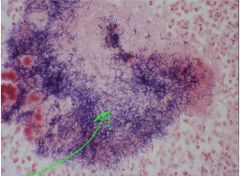
Actinomycetaceae characteristics
|
Contains genera Actinomyces, Truperella, and Actinobacterium
Gram + Many have distinctive branching filaments Modified ZN - Relatively slow growing, require Blood Agar Opportunists Pyogranulomatous reactions |
|
|
Characteristics of Trueperella pyogenes
|
Coryneform morphology
Hazy maemolysis, pin-point colonies Pitting of agar in Loeffler's slope Gram + Filamentous branching Falcultative anaerobe |
|
|
Pathogenesis of Trueperella pyogenes
|
Opportunistic
Pyolysin - hemolytic exotoxin that target cholesterol Proteases Pyogranulomatous reactions |
|
|
Clinical signs of Trueperella pyogenes
|
Suppurative lesions in any organ
Cattle, sheep, pigs: abortion (most common cause in Ireland) Summer mastitis: foul smelling, mixed infections with anaerobes |
|
|
Clinical signs of Actinomyces bovis
|
Cattle: Actinomycosis - "lumpy jaw"
Anaerobic, localized lesion that contains sulphur granules |
|
|
Clinical signs of Actinomyces viscosus
|
Dogs: canine actinomycosis - cutaneous pyogranulomas, pyothorax and pyogranulomatous pleural lesions
|
|
|
Characteristics of Dermatophilus congolensis
|
Motile coccal zoospores
Smears from scabs stained with Giemsa to see zoospore tram-tracks Persist in foci in skin Survive in scabs in environment |
|
|
Pathogenesis of Dermatophilus congolensis
|
Carboxiphylic: 5-10% CO2 for culture growth
Predisposing factors: prolonged wetting, abrasions |
|
|
Clinical signs of Dermatophilus congolensis
|
Pustules/scabs on face, limbs and/or back
Skin infections in large animals - most in subtropical climates; "Mud fever", Rain scald in horses Uncommon but not exotic in Ireland |
|
|
Treatment of Dermatophilus congolensis
|
Parenteral antibiotics
|
|
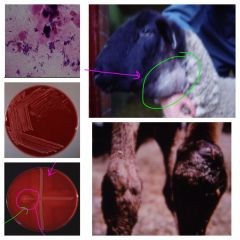
Name the bacteria
|
Corynebacteria pseudotuberculosis
|
|
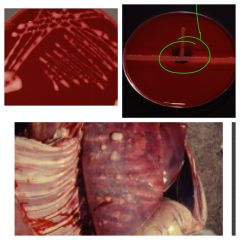
Name this bacteria
|
Rhodococcus equi
|
|

Name this bacteria
|
Nocardia asteroide
|
|
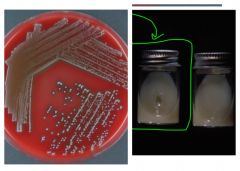
Name this bacteria
|
Trueperella pyogenes
|
|
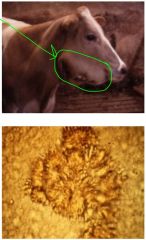
Name the genus of the bacterium that causes these conditions.
|
Actinomyces spp.
|
|
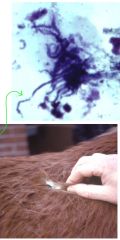
Name the bacteria
|
Dermatophilus congolensis
|

